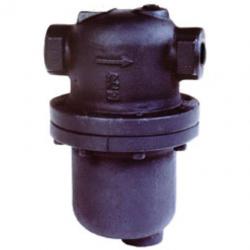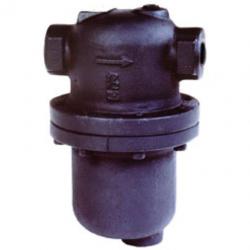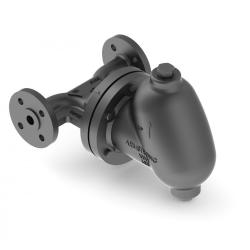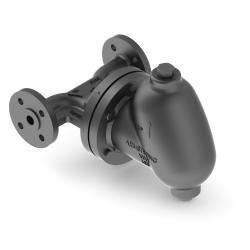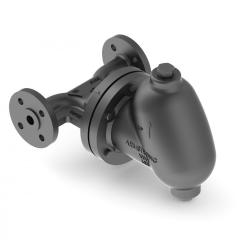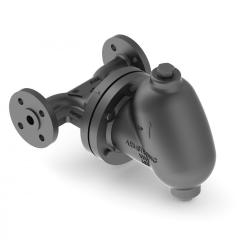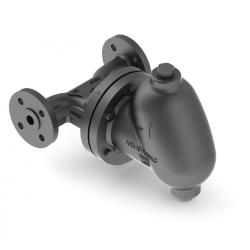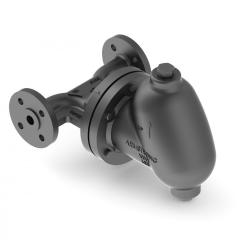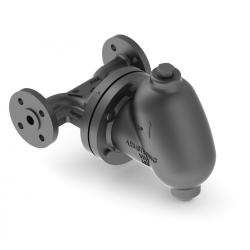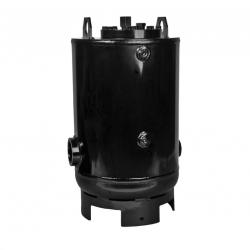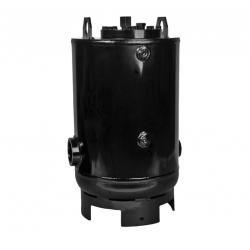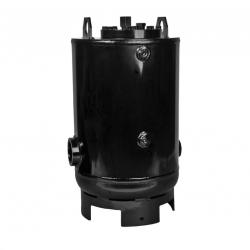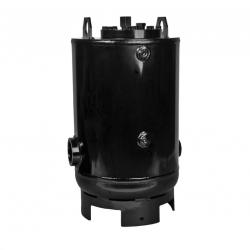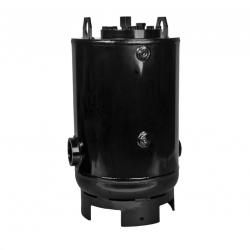Armstrong International
Avery
View:
Active Filters :
- Brand: Avery Armstrong International
- Material: Carbon Steel
- Alt. Size: 1-1/2"
Part #:501-D32374
- DS Series In-Line Condensate SeparatorsCarbon Steel Drain SeparatorCondensate in steam and air piping reduces thermal efficiency, causes water hammer, corrodes equipment such as valves and pipes, and causes other problems.
In-line (drain) separators DS-1, DS-2, DS-3, and DS-4 separate condensate efficiently by using the centrifugal force of steam or air created by introducing it into a specifically shaped path. Because of the simple structure of the drain separators, pressure loss is minimized, enabling clean, dry steam or air to be fed to equipment.
When steam or air flow enters the drain separator, centrifugal force is generated in the fluid because of the devices internal structural design. The fluid drains along the wall because of the difference in specific gravity with steam or air, eventually striking the baffle. The baffle guides the fluid to the drain outlet and to the trap, which drains it. As a result, small dirt particles and condensate are separated and removed from the system through the bottom drain.
• Cyclone structure maximizes liquid separation efficiency
• Pressure loss is extremely low
• No moving parts means no breakdowns
Qty:
Part #:501-D33858
- DS Series In-Line Condensate SeparatorsCarbon Steel Drain SeparatorCondensate in steam and air piping reduces thermal efficiency, causes water hammer, corrodes equipment such as valves and pipes, and causes other problems.
In-line (drain) separators DS-1, DS-2, DS-3, and DS-4 separate condensate efficiently by using the centrifugal force of steam or air created by introducing it into a specifically shaped path. Because of the simple structure of the drain separators, pressure loss is minimized, enabling clean, dry steam or air to be fed to equipment.
When steam or air flow enters the drain separator, centrifugal force is generated in the fluid because of the devices internal structural design. The fluid drains along the wall because of the difference in specific gravity with steam or air, eventually striking the baffle. The baffle guides the fluid to the drain outlet and to the trap, which drains it. As a result, small dirt particles and condensate are separated and removed from the system through the bottom drain.
• Cyclone structure maximizes liquid separation efficiency
• Pressure loss is extremely low
• No moving parts means no breakdowns
Qty:
Part #:501-D33859
- DS Series In-Line Condensate SeparatorsCarbon Steel Drain SeparatorCondensate in steam and air piping reduces thermal efficiency, causes water hammer, corrodes equipment such as valves and pipes, and causes other problems.
In-line (drain) separators DS-1, DS-2, DS-3, and DS-4 separate condensate efficiently by using the centrifugal force of steam or air created by introducing it into a specifically shaped path. Because of the simple structure of the drain separators, pressure loss is minimized, enabling clean, dry steam or air to be fed to equipment.
When steam or air flow enters the drain separator, centrifugal force is generated in the fluid because of the devices internal structural design. The fluid drains along the wall because of the difference in specific gravity with steam or air, eventually striking the baffle. The baffle guides the fluid to the drain outlet and to the trap, which drains it. As a result, small dirt particles and condensate are separated and removed from the system through the bottom drain.
• Cyclone structure maximizes liquid separation efficiency
• Pressure loss is extremely low
• No moving parts means no breakdowns
Qty:
Part #:501-D504109
- B Series Cast Carbon Steel Y-Type Pipe Strainer Y-Type Cast Carbon Steel (WCB) Strainer
• 600lb and 900lb Screwed or Socketweld 1/2in - 3in
• Class 150, 300 Flanged 1/2in - 6in
• Class 600 Flanged 1/2in - 4inScreen chambers won't leak or crush
Both ends of the chambers are precisely machined. This means perfectly round and smooth seating surfaces, as well as a fixed chamber length. Since the screen seats snugly on the machined surface, no particle bigger than the screen opening can escape around the end of the screen.
Screwed retainers easy in, easy out
Straight threads mean it takes less torque to achieve a tight seal with proper gasket compression. Less torque is also required to remove the retainer. For you, that means less danger of "freezing in" than with hard-to-break tapered pipe threads.
Off-center blowdown connections for better dirt removal
Off-center drains on 2-1/2" and 3" strainers allow you to remove liquid and dirt nearly completely when blowing down the strainer. Also, less liquid will spill when the screen retainer is removed.
Many screen choices
Many screen materials, meshes and perforations are available.
Qty:
Part #:501-D591024
- Float and Thermostatic (F&T) Steam TrapsThe More Your Steam Pressure Varies, The More You Need Armstrong F&T TrapsWhen steam pressure may vary from maximum steam supply pressure to vacuum, Armstrong F&Ts are your most energy-efficient choice. Our line of F&Ts brings Armstrong performance, dependability and long life to trapping services requiring continuous drainage with high air venting capacity. Thanks to separate orifices for condensate and air, they provide continuous condensate drainage and air venting-even under conditions of zero pressure.
All the benefits detailed here have been designed into Armstrong F&Ts through long experience in the manufacture of pressure float-type traps. They assure you of optimum operating efficiency for long periods with minimum trouble.
How they work
Float and thermostatic traps are mechanical units that operate on both density and temperature principles. The float valve operates on the density principle. A level connects the ball float to the valve and seat. Once condensate reaches a certain level in the trap, the float rises, opening the orifice and draining condensate. A water seal formed by the condensate prevents live steam loss.
Since the discharge valve is under water, it is not capable of venting air and non-condensables. When the accumulation of air and con-condensable gases causes a significant temperature drop, a thermostatic air vent in the top of the trap discharges them. The thermostatic vent opens at a temperature a few degrees below saturation, so it's able to handle a large volume of air-through an entirely separate orifice-but at a slightly reduced temperature.
Built as tough as the jobs they do
Armstrong float and thermostatic traps are unique in their super heavy duty construction. Armstrong uses high quality ASTM A48 Class 30 cast iron or ASTM A216 WCB cast steel-normally found in pressure vessels rated to 250 psi (17 bar) or 465 psi (32 bar). Internal mechanisms are made from stainless steel and are heavily reinforced. No brass cotter pins here. Valves and seats are stainless steel, hardened, ground and lapped to withstand the erosive forces of flashing condensate.
Why go to all this trouble for traps normally recommended for low-pressure, modulating service? The operative word here is modulating. Modulating pressures mean widely varying loads, thermal cycling and high air and non-condensable gas loads.
In other words tough service. Inferior, lightweight construction in this kind of service is a mistake waiting to happen. Trap failures on modulating pressure may lead to water hammer, corrosion and even damage to heat exchangers.
Armstrong's published capacities are based on actual measurements of traps handling hot, flashing condensate. Competitive F&Ts may utilize theoretical calculated capacities. Armstrong uses its own steam lab to give you actual capacity-especially important on high-capacity traps such as those in our ultra-capacity line. Not only does Armstrong offer super heavy duty construction for long life and reliability, but we also supply the data to back up performance. Here's a simple, easy-to-remember summary The more your pressure varies, the more you need Armstrong F&Ts.
Qty:
Part #:501-D591209
- Float and Thermostatic (F&T) Steam TrapsThe More Your Steam Pressure Varies, The More You Need Armstrong F&T TrapsWhen steam pressure may vary from maximum steam supply pressure to vacuum, Armstrong F&Ts are your most energy-efficient choice. Our line of F&Ts brings Armstrong performance, dependability and long life to trapping services requiring continuous drainage with high air venting capacity. Thanks to separate orifices for condensate and air, they provide continuous condensate drainage and air venting-even under conditions of zero pressure.
All the benefits detailed here have been designed into Armstrong F&Ts through long experience in the manufacture of pressure float-type traps. They assure you of optimum operating efficiency for long periods with minimum trouble.
How they work
Float and thermostatic traps are mechanical units that operate on both density and temperature principles. The float valve operates on the density principle. A level connects the ball float to the valve and seat. Once condensate reaches a certain level in the trap, the float rises, opening the orifice and draining condensate. A water seal formed by the condensate prevents live steam loss.
Since the discharge valve is under water, it is not capable of venting air and non-condensables. When the accumulation of air and con-condensable gases causes a significant temperature drop, a thermostatic air vent in the top of the trap discharges them. The thermostatic vent opens at a temperature a few degrees below saturation, so it's able to handle a large volume of air-through an entirely separate orifice-but at a slightly reduced temperature.
Built as tough as the jobs they do
Armstrong float and thermostatic traps are unique in their super heavy duty construction. Armstrong uses high quality ASTM A48 Class 30 cast iron or ASTM A216 WCB cast steel-normally found in pressure vessels rated to 250 psi (17 bar) or 465 psi (32 bar). Internal mechanisms are made from stainless steel and are heavily reinforced. No brass cotter pins here. Valves and seats are stainless steel, hardened, ground and lapped to withstand the erosive forces of flashing condensate.
Why go to all this trouble for traps normally recommended for low-pressure, modulating service? The operative word here is modulating. Modulating pressures mean widely varying loads, thermal cycling and high air and non-condensable gas loads.
In other words tough service. Inferior, lightweight construction in this kind of service is a mistake waiting to happen. Trap failures on modulating pressure may lead to water hammer, corrosion and even damage to heat exchangers.
Armstrong's published capacities are based on actual measurements of traps handling hot, flashing condensate. Competitive F&Ts may utilize theoretical calculated capacities. Armstrong uses its own steam lab to give you actual capacity-especially important on high-capacity traps such as those in our ultra-capacity line. Not only does Armstrong offer super heavy duty construction for long life and reliability, but we also supply the data to back up performance. Here's a simple, easy-to-remember summary The more your pressure varies, the more you need Armstrong F&Ts.
Qty:
Part #:501-D591354
- Float and Thermostatic (F&T) Steam TrapsThe More Your Steam Pressure Varies, The More You Need Armstrong F&T TrapsWhen steam pressure may vary from maximum steam supply pressure to vacuum, Armstrong F&Ts are your most energy-efficient choice. Our line of F&Ts brings Armstrong performance, dependability and long life to trapping services requiring continuous drainage with high air venting capacity. Thanks to separate orifices for condensate and air, they provide continuous condensate drainage and air venting-even under conditions of zero pressure.
All the benefits detailed here have been designed into Armstrong F&Ts through long experience in the manufacture of pressure float-type traps. They assure you of optimum operating efficiency for long periods with minimum trouble.
How they work
Float and thermostatic traps are mechanical units that operate on both density and temperature principles. The float valve operates on the density principle. A level connects the ball float to the valve and seat. Once condensate reaches a certain level in the trap, the float rises, opening the orifice and draining condensate. A water seal formed by the condensate prevents live steam loss.
Since the discharge valve is under water, it is not capable of venting air and non-condensables. When the accumulation of air and con-condensable gases causes a significant temperature drop, a thermostatic air vent in the top of the trap discharges them. The thermostatic vent opens at a temperature a few degrees below saturation, so it's able to handle a large volume of air-through an entirely separate orifice-but at a slightly reduced temperature.
Built as tough as the jobs they do
Armstrong float and thermostatic traps are unique in their super heavy duty construction. Armstrong uses high quality ASTM A48 Class 30 cast iron or ASTM A216 WCB cast steel-normally found in pressure vessels rated to 250 psi (17 bar) or 465 psi (32 bar). Internal mechanisms are made from stainless steel and are heavily reinforced. No brass cotter pins here. Valves and seats are stainless steel, hardened, ground and lapped to withstand the erosive forces of flashing condensate.
Why go to all this trouble for traps normally recommended for low-pressure, modulating service? The operative word here is modulating. Modulating pressures mean widely varying loads, thermal cycling and high air and non-condensable gas loads.
In other words tough service. Inferior, lightweight construction in this kind of service is a mistake waiting to happen. Trap failures on modulating pressure may lead to water hammer, corrosion and even damage to heat exchangers.
Armstrong's published capacities are based on actual measurements of traps handling hot, flashing condensate. Competitive F&Ts may utilize theoretical calculated capacities. Armstrong uses its own steam lab to give you actual capacity-especially important on high-capacity traps such as those in our ultra-capacity line. Not only does Armstrong offer super heavy duty construction for long life and reliability, but we also supply the data to back up performance. Here's a simple, easy-to-remember summary The more your pressure varies, the more you need Armstrong F&Ts.
Qty:
Part #:501-D591676
- Float and Thermostatic (F&T) Steam TrapsThe More Your Steam Pressure Varies, The More You Need Armstrong F&T TrapsWhen steam pressure may vary from maximum steam supply pressure to vacuum, Armstrong F&Ts are your most energy-efficient choice. Our line of F&Ts brings Armstrong performance, dependability and long life to trapping services requiring continuous drainage with high air venting capacity. Thanks to separate orifices for condensate and air, they provide continuous condensate drainage and air venting-even under conditions of zero pressure.
All the benefits detailed here have been designed into Armstrong F&Ts through long experience in the manufacture of pressure float-type traps. They assure you of optimum operating efficiency for long periods with minimum trouble.
How they work
Float and thermostatic traps are mechanical units that operate on both density and temperature principles. The float valve operates on the density principle. A level connects the ball float to the valve and seat. Once condensate reaches a certain level in the trap, the float rises, opening the orifice and draining condensate. A water seal formed by the condensate prevents live steam loss.
Since the discharge valve is under water, it is not capable of venting air and non-condensables. When the accumulation of air and con-condensable gases causes a significant temperature drop, a thermostatic air vent in the top of the trap discharges them. The thermostatic vent opens at a temperature a few degrees below saturation, so it's able to handle a large volume of air-through an entirely separate orifice-but at a slightly reduced temperature.
Built as tough as the jobs they do
Armstrong float and thermostatic traps are unique in their super heavy duty construction. Armstrong uses high quality ASTM A48 Class 30 cast iron or ASTM A216 WCB cast steel-normally found in pressure vessels rated to 250 psi (17 bar) or 465 psi (32 bar). Internal mechanisms are made from stainless steel and are heavily reinforced. No brass cotter pins here. Valves and seats are stainless steel, hardened, ground and lapped to withstand the erosive forces of flashing condensate.
Why go to all this trouble for traps normally recommended for low-pressure, modulating service? The operative word here is modulating. Modulating pressures mean widely varying loads, thermal cycling and high air and non-condensable gas loads.
In other words tough service. Inferior, lightweight construction in this kind of service is a mistake waiting to happen. Trap failures on modulating pressure may lead to water hammer, corrosion and even damage to heat exchangers.
Armstrong's published capacities are based on actual measurements of traps handling hot, flashing condensate. Competitive F&Ts may utilize theoretical calculated capacities. Armstrong uses its own steam lab to give you actual capacity-especially important on high-capacity traps such as those in our ultra-capacity line. Not only does Armstrong offer super heavy duty construction for long life and reliability, but we also supply the data to back up performance. Here's a simple, easy-to-remember summary The more your pressure varies, the more you need Armstrong F&Ts.
Qty:
Part #:501-D592633
- Float and Thermostatic (F&T) Steam TrapsThe More Your Steam Pressure Varies, The More You Need Armstrong F&T TrapsWhen steam pressure may vary from maximum steam supply pressure to vacuum, Armstrong F&Ts are your most energy-efficient choice. Our line of F&Ts brings Armstrong performance, dependability and long life to trapping services requiring continuous drainage with high air venting capacity. Thanks to separate orifices for condensate and air, they provide continuous condensate drainage and air venting-even under conditions of zero pressure.
All the benefits detailed here have been designed into Armstrong F&Ts through long experience in the manufacture of pressure float-type traps. They assure you of optimum operating efficiency for long periods with minimum trouble.
How they work
Float and thermostatic traps are mechanical units that operate on both density and temperature principles. The float valve operates on the density principle. A level connects the ball float to the valve and seat. Once condensate reaches a certain level in the trap, the float rises, opening the orifice and draining condensate. A water seal formed by the condensate prevents live steam loss.
Since the discharge valve is under water, it is not capable of venting air and non-condensables. When the accumulation of air and con-condensable gases causes a significant temperature drop, a thermostatic air vent in the top of the trap discharges them. The thermostatic vent opens at a temperature a few degrees below saturation, so it's able to handle a large volume of air-through an entirely separate orifice-but at a slightly reduced temperature.
Built as tough as the jobs they do
Armstrong float and thermostatic traps are unique in their super heavy duty construction. Armstrong uses high quality ASTM A48 Class 30 cast iron or ASTM A216 WCB cast steel-normally found in pressure vessels rated to 250 psi (17 bar) or 465 psi (32 bar). Internal mechanisms are made from stainless steel and are heavily reinforced. No brass cotter pins here. Valves and seats are stainless steel, hardened, ground and lapped to withstand the erosive forces of flashing condensate.
Why go to all this trouble for traps normally recommended for low-pressure, modulating service? The operative word here is modulating. Modulating pressures mean widely varying loads, thermal cycling and high air and non-condensable gas loads.
In other words tough service. Inferior, lightweight construction in this kind of service is a mistake waiting to happen. Trap failures on modulating pressure may lead to water hammer, corrosion and even damage to heat exchangers.
Armstrong's published capacities are based on actual measurements of traps handling hot, flashing condensate. Competitive F&Ts may utilize theoretical calculated capacities. Armstrong uses its own steam lab to give you actual capacity-especially important on high-capacity traps such as those in our ultra-capacity line. Not only does Armstrong offer super heavy duty construction for long life and reliability, but we also supply the data to back up performance. Here's a simple, easy-to-remember summary The more your pressure varies, the more you need Armstrong F&Ts.
Qty:
Part #:501-D592977
- Float and Thermostatic (F&T) Steam TrapsThe More Your Steam Pressure Varies, The More You Need Armstrong F&T TrapsWhen steam pressure may vary from maximum steam supply pressure to vacuum, Armstrong F&Ts are your most energy-efficient choice. Our line of F&Ts brings Armstrong performance, dependability and long life to trapping services requiring continuous drainage with high air venting capacity. Thanks to separate orifices for condensate and air, they provide continuous condensate drainage and air venting-even under conditions of zero pressure.
All the benefits detailed here have been designed into Armstrong F&Ts through long experience in the manufacture of pressure float-type traps. They assure you of optimum operating efficiency for long periods with minimum trouble.
How they work
Float and thermostatic traps are mechanical units that operate on both density and temperature principles. The float valve operates on the density principle. A level connects the ball float to the valve and seat. Once condensate reaches a certain level in the trap, the float rises, opening the orifice and draining condensate. A water seal formed by the condensate prevents live steam loss.
Since the discharge valve is under water, it is not capable of venting air and non-condensables. When the accumulation of air and con-condensable gases causes a significant temperature drop, a thermostatic air vent in the top of the trap discharges them. The thermostatic vent opens at a temperature a few degrees below saturation, so it's able to handle a large volume of air-through an entirely separate orifice-but at a slightly reduced temperature.
Built as tough as the jobs they do
Armstrong float and thermostatic traps are unique in their super heavy duty construction. Armstrong uses high quality ASTM A48 Class 30 cast iron or ASTM A216 WCB cast steel-normally found in pressure vessels rated to 250 psi (17 bar) or 465 psi (32 bar). Internal mechanisms are made from stainless steel and are heavily reinforced. No brass cotter pins here. Valves and seats are stainless steel, hardened, ground and lapped to withstand the erosive forces of flashing condensate.
Why go to all this trouble for traps normally recommended for low-pressure, modulating service? The operative word here is modulating. Modulating pressures mean widely varying loads, thermal cycling and high air and non-condensable gas loads.
In other words tough service. Inferior, lightweight construction in this kind of service is a mistake waiting to happen. Trap failures on modulating pressure may lead to water hammer, corrosion and even damage to heat exchangers.
Armstrong's published capacities are based on actual measurements of traps handling hot, flashing condensate. Competitive F&Ts may utilize theoretical calculated capacities. Armstrong uses its own steam lab to give you actual capacity-especially important on high-capacity traps such as those in our ultra-capacity line. Not only does Armstrong offer super heavy duty construction for long life and reliability, but we also supply the data to back up performance. Here's a simple, easy-to-remember summary The more your pressure varies, the more you need Armstrong F&Ts.
Qty:
Part #:501-D593008
- Float and Thermostatic (F&T) Steam TrapsThe More Your Steam Pressure Varies, The More You Need Armstrong F&T TrapsWhen steam pressure may vary from maximum steam supply pressure to vacuum, Armstrong F&Ts are your most energy-efficient choice. Our line of F&Ts brings Armstrong performance, dependability and long life to trapping services requiring continuous drainage with high air venting capacity. Thanks to separate orifices for condensate and air, they provide continuous condensate drainage and air venting-even under conditions of zero pressure.
All the benefits detailed here have been designed into Armstrong F&Ts through long experience in the manufacture of pressure float-type traps. They assure you of optimum operating efficiency for long periods with minimum trouble.
How they work
Float and thermostatic traps are mechanical units that operate on both density and temperature principles. The float valve operates on the density principle. A level connects the ball float to the valve and seat. Once condensate reaches a certain level in the trap, the float rises, opening the orifice and draining condensate. A water seal formed by the condensate prevents live steam loss.
Since the discharge valve is under water, it is not capable of venting air and non-condensables. When the accumulation of air and con-condensable gases causes a significant temperature drop, a thermostatic air vent in the top of the trap discharges them. The thermostatic vent opens at a temperature a few degrees below saturation, so it's able to handle a large volume of air-through an entirely separate orifice-but at a slightly reduced temperature.
Built as tough as the jobs they do
Armstrong float and thermostatic traps are unique in their super heavy duty construction. Armstrong uses high quality ASTM A48 Class 30 cast iron or ASTM A216 WCB cast steel-normally found in pressure vessels rated to 250 psi (17 bar) or 465 psi (32 bar). Internal mechanisms are made from stainless steel and are heavily reinforced. No brass cotter pins here. Valves and seats are stainless steel, hardened, ground and lapped to withstand the erosive forces of flashing condensate.
Why go to all this trouble for traps normally recommended for low-pressure, modulating service? The operative word here is modulating. Modulating pressures mean widely varying loads, thermal cycling and high air and non-condensable gas loads.
In other words tough service. Inferior, lightweight construction in this kind of service is a mistake waiting to happen. Trap failures on modulating pressure may lead to water hammer, corrosion and even damage to heat exchangers.
Armstrong's published capacities are based on actual measurements of traps handling hot, flashing condensate. Competitive F&Ts may utilize theoretical calculated capacities. Armstrong uses its own steam lab to give you actual capacity-especially important on high-capacity traps such as those in our ultra-capacity line. Not only does Armstrong offer super heavy duty construction for long life and reliability, but we also supply the data to back up performance. Here's a simple, easy-to-remember summary The more your pressure varies, the more you need Armstrong F&Ts.
Qty:
Part #:501-D593113
- Float and Thermostatic (F&T) Steam TrapsThe More Your Steam Pressure Varies, The More You Need Armstrong F&T TrapsWhen steam pressure may vary from maximum steam supply pressure to vacuum, Armstrong F&Ts are your most energy-efficient choice. Our line of F&Ts brings Armstrong performance, dependability and long life to trapping services requiring continuous drainage with high air venting capacity. Thanks to separate orifices for condensate and air, they provide continuous condensate drainage and air venting-even under conditions of zero pressure.
All the benefits detailed here have been designed into Armstrong F&Ts through long experience in the manufacture of pressure float-type traps. They assure you of optimum operating efficiency for long periods with minimum trouble.
How they work
Float and thermostatic traps are mechanical units that operate on both density and temperature principles. The float valve operates on the density principle. A level connects the ball float to the valve and seat. Once condensate reaches a certain level in the trap, the float rises, opening the orifice and draining condensate. A water seal formed by the condensate prevents live steam loss.
Since the discharge valve is under water, it is not capable of venting air and non-condensables. When the accumulation of air and con-condensable gases causes a significant temperature drop, a thermostatic air vent in the top of the trap discharges them. The thermostatic vent opens at a temperature a few degrees below saturation, so it's able to handle a large volume of air-through an entirely separate orifice-but at a slightly reduced temperature.
Built as tough as the jobs they do
Armstrong float and thermostatic traps are unique in their super heavy duty construction. Armstrong uses high quality ASTM A48 Class 30 cast iron or ASTM A216 WCB cast steel-normally found in pressure vessels rated to 250 psi (17 bar) or 465 psi (32 bar). Internal mechanisms are made from stainless steel and are heavily reinforced. No brass cotter pins here. Valves and seats are stainless steel, hardened, ground and lapped to withstand the erosive forces of flashing condensate.
Why go to all this trouble for traps normally recommended for low-pressure, modulating service? The operative word here is modulating. Modulating pressures mean widely varying loads, thermal cycling and high air and non-condensable gas loads.
In other words tough service. Inferior, lightweight construction in this kind of service is a mistake waiting to happen. Trap failures on modulating pressure may lead to water hammer, corrosion and even damage to heat exchangers.
Armstrong's published capacities are based on actual measurements of traps handling hot, flashing condensate. Competitive F&Ts may utilize theoretical calculated capacities. Armstrong uses its own steam lab to give you actual capacity-especially important on high-capacity traps such as those in our ultra-capacity line. Not only does Armstrong offer super heavy duty construction for long life and reliability, but we also supply the data to back up performance. Here's a simple, easy-to-remember summary The more your pressure varies, the more you need Armstrong F&Ts.
Qty:
Part #:501-D593619
- Float and Thermostatic (F&T) Steam TrapsThe More Your Steam Pressure Varies, The More You Need Armstrong F&T TrapsWhen steam pressure may vary from maximum steam supply pressure to vacuum, Armstrong F&Ts are your most energy-efficient choice. Our line of F&Ts brings Armstrong performance, dependability and long life to trapping services requiring continuous drainage with high air venting capacity. Thanks to separate orifices for condensate and air, they provide continuous condensate drainage and air venting-even under conditions of zero pressure.
All the benefits detailed here have been designed into Armstrong F&Ts through long experience in the manufacture of pressure float-type traps. They assure you of optimum operating efficiency for long periods with minimum trouble.
How they work
Float and thermostatic traps are mechanical units that operate on both density and temperature principles. The float valve operates on the density principle. A level connects the ball float to the valve and seat. Once condensate reaches a certain level in the trap, the float rises, opening the orifice and draining condensate. A water seal formed by the condensate prevents live steam loss.
Since the discharge valve is under water, it is not capable of venting air and non-condensables. When the accumulation of air and con-condensable gases causes a significant temperature drop, a thermostatic air vent in the top of the trap discharges them. The thermostatic vent opens at a temperature a few degrees below saturation, so it's able to handle a large volume of air-through an entirely separate orifice-but at a slightly reduced temperature.
Built as tough as the jobs they do
Armstrong float and thermostatic traps are unique in their super heavy duty construction. Armstrong uses high quality ASTM A48 Class 30 cast iron or ASTM A216 WCB cast steel-normally found in pressure vessels rated to 250 psi (17 bar) or 465 psi (32 bar). Internal mechanisms are made from stainless steel and are heavily reinforced. No brass cotter pins here. Valves and seats are stainless steel, hardened, ground and lapped to withstand the erosive forces of flashing condensate.
Why go to all this trouble for traps normally recommended for low-pressure, modulating service? The operative word here is modulating. Modulating pressures mean widely varying loads, thermal cycling and high air and non-condensable gas loads.
In other words tough service. Inferior, lightweight construction in this kind of service is a mistake waiting to happen. Trap failures on modulating pressure may lead to water hammer, corrosion and even damage to heat exchangers.
Armstrong's published capacities are based on actual measurements of traps handling hot, flashing condensate. Competitive F&Ts may utilize theoretical calculated capacities. Armstrong uses its own steam lab to give you actual capacity-especially important on high-capacity traps such as those in our ultra-capacity line. Not only does Armstrong offer super heavy duty construction for long life and reliability, but we also supply the data to back up performance. Here's a simple, easy-to-remember summary The more your pressure varies, the more you need Armstrong F&Ts.
Qty:
Part #:501-D594465
- Float and Thermostatic (F&T) Steam TrapsThe More Your Steam Pressure Varies, The More You Need Armstrong F&T TrapsWhen steam pressure may vary from maximum steam supply pressure to vacuum, Armstrong F&Ts are your most energy-efficient choice. Our line of F&Ts brings Armstrong performance, dependability and long life to trapping services requiring continuous drainage with high air venting capacity. Thanks to separate orifices for condensate and air, they provide continuous condensate drainage and air venting-even under conditions of zero pressure.
All the benefits detailed here have been designed into Armstrong F&Ts through long experience in the manufacture of pressure float-type traps. They assure you of optimum operating efficiency for long periods with minimum trouble.
How they work
Float and thermostatic traps are mechanical units that operate on both density and temperature principles. The float valve operates on the density principle. A level connects the ball float to the valve and seat. Once condensate reaches a certain level in the trap, the float rises, opening the orifice and draining condensate. A water seal formed by the condensate prevents live steam loss.
Since the discharge valve is under water, it is not capable of venting air and non-condensables. When the accumulation of air and con-condensable gases causes a significant temperature drop, a thermostatic air vent in the top of the trap discharges them. The thermostatic vent opens at a temperature a few degrees below saturation, so it's able to handle a large volume of air-through an entirely separate orifice-but at a slightly reduced temperature.
Built as tough as the jobs they do
Armstrong float and thermostatic traps are unique in their super heavy duty construction. Armstrong uses high quality ASTM A48 Class 30 cast iron or ASTM A216 WCB cast steel-normally found in pressure vessels rated to 250 psi (17 bar) or 465 psi (32 bar). Internal mechanisms are made from stainless steel and are heavily reinforced. No brass cotter pins here. Valves and seats are stainless steel, hardened, ground and lapped to withstand the erosive forces of flashing condensate.
Why go to all this trouble for traps normally recommended for low-pressure, modulating service? The operative word here is modulating. Modulating pressures mean widely varying loads, thermal cycling and high air and non-condensable gas loads.
In other words tough service. Inferior, lightweight construction in this kind of service is a mistake waiting to happen. Trap failures on modulating pressure may lead to water hammer, corrosion and even damage to heat exchangers.
Armstrong's published capacities are based on actual measurements of traps handling hot, flashing condensate. Competitive F&Ts may utilize theoretical calculated capacities. Armstrong uses its own steam lab to give you actual capacity-especially important on high-capacity traps such as those in our ultra-capacity line. Not only does Armstrong offer super heavy duty construction for long life and reliability, but we also supply the data to back up performance. Here's a simple, easy-to-remember summary The more your pressure varies, the more you need Armstrong F&Ts.
Qty:
Part #:501-D595749
- Float and Thermostatic (F&T) Steam TrapsThe More Your Steam Pressure Varies, The More You Need Armstrong F&T TrapsWhen steam pressure may vary from maximum steam supply pressure to vacuum, Armstrong F&Ts are your most energy-efficient choice. Our line of F&Ts brings Armstrong performance, dependability and long life to trapping services requiring continuous drainage with high air venting capacity. Thanks to separate orifices for condensate and air, they provide continuous condensate drainage and air venting-even under conditions of zero pressure.
All the benefits detailed here have been designed into Armstrong F&Ts through long experience in the manufacture of pressure float-type traps. They assure you of optimum operating efficiency for long periods with minimum trouble.
How they work
Float and thermostatic traps are mechanical units that operate on both density and temperature principles. The float valve operates on the density principle. A level connects the ball float to the valve and seat. Once condensate reaches a certain level in the trap, the float rises, opening the orifice and draining condensate. A water seal formed by the condensate prevents live steam loss.
Since the discharge valve is under water, it is not capable of venting air and non-condensables. When the accumulation of air and con-condensable gases causes a significant temperature drop, a thermostatic air vent in the top of the trap discharges them. The thermostatic vent opens at a temperature a few degrees below saturation, so it's able to handle a large volume of air-through an entirely separate orifice-but at a slightly reduced temperature.
Built as tough as the jobs they do
Armstrong float and thermostatic traps are unique in their super heavy duty construction. Armstrong uses high quality ASTM A48 Class 30 cast iron or ASTM A216 WCB cast steel-normally found in pressure vessels rated to 250 psi (17 bar) or 465 psi (32 bar). Internal mechanisms are made from stainless steel and are heavily reinforced. No brass cotter pins here. Valves and seats are stainless steel, hardened, ground and lapped to withstand the erosive forces of flashing condensate.
Why go to all this trouble for traps normally recommended for low-pressure, modulating service? The operative word here is modulating. Modulating pressures mean widely varying loads, thermal cycling and high air and non-condensable gas loads.
In other words tough service. Inferior, lightweight construction in this kind of service is a mistake waiting to happen. Trap failures on modulating pressure may lead to water hammer, corrosion and even damage to heat exchangers.
Armstrong's published capacities are based on actual measurements of traps handling hot, flashing condensate. Competitive F&Ts may utilize theoretical calculated capacities. Armstrong uses its own steam lab to give you actual capacity-especially important on high-capacity traps such as those in our ultra-capacity line. Not only does Armstrong offer super heavy duty construction for long life and reliability, but we also supply the data to back up performance. Here's a simple, easy-to-remember summary The more your pressure varies, the more you need Armstrong F&Ts.
Qty:
Part #:501-D596668
- Float and Thermostatic (F&T) Steam TrapsThe More Your Steam Pressure Varies, The More You Need Armstrong F&T TrapsWhen steam pressure may vary from maximum steam supply pressure to vacuum, Armstrong F&Ts are your most energy-efficient choice. Our line of F&Ts brings Armstrong performance, dependability and long life to trapping services requiring continuous drainage with high air venting capacity. Thanks to separate orifices for condensate and air, they provide continuous condensate drainage and air venting-even under conditions of zero pressure.
All the benefits detailed here have been designed into Armstrong F&Ts through long experience in the manufacture of pressure float-type traps. They assure you of optimum operating efficiency for long periods with minimum trouble.
How they work
Float and thermostatic traps are mechanical units that operate on both density and temperature principles. The float valve operates on the density principle. A level connects the ball float to the valve and seat. Once condensate reaches a certain level in the trap, the float rises, opening the orifice and draining condensate. A water seal formed by the condensate prevents live steam loss.
Since the discharge valve is under water, it is not capable of venting air and non-condensables. When the accumulation of air and con-condensable gases causes a significant temperature drop, a thermostatic air vent in the top of the trap discharges them. The thermostatic vent opens at a temperature a few degrees below saturation, so it's able to handle a large volume of air-through an entirely separate orifice-but at a slightly reduced temperature.
Built as tough as the jobs they do
Armstrong float and thermostatic traps are unique in their super heavy duty construction. Armstrong uses high quality ASTM A48 Class 30 cast iron or ASTM A216 WCB cast steel-normally found in pressure vessels rated to 250 psi (17 bar) or 465 psi (32 bar). Internal mechanisms are made from stainless steel and are heavily reinforced. No brass cotter pins here. Valves and seats are stainless steel, hardened, ground and lapped to withstand the erosive forces of flashing condensate.
Why go to all this trouble for traps normally recommended for low-pressure, modulating service? The operative word here is modulating. Modulating pressures mean widely varying loads, thermal cycling and high air and non-condensable gas loads.
In other words tough service. Inferior, lightweight construction in this kind of service is a mistake waiting to happen. Trap failures on modulating pressure may lead to water hammer, corrosion and even damage to heat exchangers.
Armstrong's published capacities are based on actual measurements of traps handling hot, flashing condensate. Competitive F&Ts may utilize theoretical calculated capacities. Armstrong uses its own steam lab to give you actual capacity-especially important on high-capacity traps such as those in our ultra-capacity line. Not only does Armstrong offer super heavy duty construction for long life and reliability, but we also supply the data to back up performance. Here's a simple, easy-to-remember summary The more your pressure varies, the more you need Armstrong F&Ts.
Qty:
Part #:501-FH1003
- Pumping TrapsArmstrong pump traps offer the following features, advantages and benefits Non-electric Utilizes inexpensive steam, air or gas for operation and has no seals, motors, impellers or electric components, which frequently fail. Wear and corrosion resistance. Mechanism frame assembly is constructed of rugged investment-cast stainless steel components. Stress chloride corrosion resistance Inconel X-750 springs have higher resistance to the stress that causes lower-grade stainless steel springs to fail. Corrosion resistance Entire float mechanism is stainless steel. Float is Heliarc welded to avoid the introduction of dissimilar metals, which could lead to galvanic corrosion and float failure. Externally replaceable valve and seat assembly Maintenance is a "snap" with hardened stainless steel valves that can be cleaned or replaced without cap removal. Explosion proof Intrinsically safe due to all-stainless steel construction of mechanism. Long life and dependable service. Simple float/spring operation and rugged all-stainless steel construction allow for long, trouble-free service life. Compact, low-profile design Low-profile design allows for maximum pump capacity with minimal fill head and floor space requirements. PT-300 Series horizontal tank design provides the highest capacity with the lowest profile on the market.
PT-400 SeriesFabricated SteelFor pressures to 150 psig (10.3 bar)Capacities to 80,000 lb/hr (36,287 kg/hr)The Armstrong PT-400 Series Vertical Pump Trap is the low-maintenance, non-electric solution to moving condensate or other liquids from low points, low pressures or vacuum spaces to an area of higher elevation or pressure. Condensate can be returned at temperatures well above the 200F (93C) limit of conventional electric condensate pumps without leaking seals or cavitation problems.Economical non-electric operation.Uses inexpensive steam air or inert gas.Low-maintenance operation.No leaking seals, impeller or motor problems means lower maintenance. No NPSH issues.Lower installation costs.Single trade required for installation and maintenance.Peace of mind.Standard unit is intrinsically safe&mdashexplosion-proof.Durable construction.ASME code-stamped carbon steel body vessel.Corrosion resistance.Internals are all stainless steel for corrosion resistance and long life.Heavy-duty springs.Springs are made from long-lasting Inconel X-750.Efficiency.A closed loop means no motive or flash steam is lost. All valuable Btu&rsquos are captured and returned to the system.Safety.The pump can be used in flooded pits without fear of electrocution or circuit breaker defaults.Externally removable/replaceable seats.Seats can be replaced or cleaned without removing the mechanism assembly.Typical applications&bull Low-pressure heating systems&bull Process heat exchanger or coils with modulating steam control&bull Remote installations (tracing, tank farms, or remote coils)&bull Systems under vacuum&bull Hazardous (explosion-proof) areas&bull Caustic environments&bull Sumps or submersed areas&bull Reboilers&bull Flash tanksNOTE Armstrong can also custom fabricate packages to meet your specific needs. Pre-piped conventional, low-boy, closed-loop and custom-fabricated skid packages are available.
Qty:
Part #:501-FH1003-A
- Pumping TrapsArmstrong pump traps offer the following features, advantages and benefits Non-electric Utilizes inexpensive steam, air or gas for operation and has no seals, motors, impellers or electric components, which frequently fail. Wear and corrosion resistance. Mechanism frame assembly is constructed of rugged investment-cast stainless steel components. Stress chloride corrosion resistance Inconel X-750 springs have higher resistance to the stress that causes lower-grade stainless steel springs to fail. Corrosion resistance Entire float mechanism is stainless steel. Float is Heliarc welded to avoid the introduction of dissimilar metals, which could lead to galvanic corrosion and float failure. Externally replaceable valve and seat assembly Maintenance is a "snap" with hardened stainless steel valves that can be cleaned or replaced without cap removal. Explosion proof Intrinsically safe due to all-stainless steel construction of mechanism. Long life and dependable service. Simple float/spring operation and rugged all-stainless steel construction allow for long, trouble-free service life. Compact, low-profile design Low-profile design allows for maximum pump capacity with minimal fill head and floor space requirements. PT-300 Series horizontal tank design provides the highest capacity with the lowest profile on the market.
PT-400 Series, PT406, PT406CVFabricated SteelFor pressures to 150 psig (10.3 bar)Capacities to 80,000 lb/hr (36,287 kg/hr)The Armstrong PT-400 Series Vertical Pump Trap is the low-maintenance, non-electric solution to moving condensate or other liquids from low points, low pressures or vacuum spaces to an area of higher elevation or pressure. Condensate can be returned at temperatures well above the 200F (93C) limit of conventional electric condensate pumps without leaking seals or cavitation problems.Economical non-electric operation.Uses inexpensive steam air or inert gas.Low-maintenance operation.No leaking seals, impeller or motor problems means lower maintenance. No NPSH issues.Lower installation costs.Single trade required for installation and maintenance.Peace of mind.Standard unit is intrinsically safe&mdashexplosion-proof.Durable construction.ASME code-stamped carbon steel body vessel.Corrosion resistance.Internals are all stainless steel for corrosion resistance and long life.Heavy-duty springs.Springs are made from long-lasting Inconel X-750.Efficiency.A closed loop means no motive or flash steam is lost. All valuable Btu&rsquos are captured and returned to the system.Safety.The pump can be used in flooded pits without fear of electrocution or circuit breaker defaults.Externally removable/replaceable seats.Seats can be replaced or cleaned without removing the mechanism assembly.Typical applications&bull Low-pressure heating systems&bull Process heat exchanger or coils with modulating steam control&bull Remote installations (tracing, tank farms, or remote coils)&bull Systems under vacuum&bull Hazardous (explosion-proof) areas&bull Caustic environments&bull Sumps or submersed areas&bull Reboilers&bull Flash tanksNOTE Armstrong can also custom fabricate packages to meet your specific needs. Pre-piped conventional, low-boy, closed-loop and custom-fabricated skid packages are available.
Qty:
Part #:501-FH1003-B
- Pumping TrapsArmstrong pump traps offer the following features, advantages and benefits
Non-electric
Utilizes inexpensive steam, air or gas for operation and has no seals, motors, impellers or electric components, which frequently fail.
Wear and corrosion resistance.
Mechanism frame assembly is constructed of rugged investment-cast stainless steel components.
Stress chloride corrosion resistance
Inconel X-750 springs have higher resistance to the stress that causes lower-grade stainless steel springs to fail.
Corrosion resistance
Entire float mechanism is stainless steel. Float is Heliarc welded to avoid the introduction of dissimilar metals, which could lead to galvanic corrosion and float failure.
Externally replaceable valve and seat assembly
Maintenance is a "snap" with hardened stainless steel valves that can be cleaned or replaced without cap removal.
Explosion proof
Intrinsically safe due to all-stainless steel construction of mechanism.
Long life and dependable service.
Simple float/spring operation and rugged all-stainless steel construction allow for long, trouble-free service life.
Compact, low-profile design
Low-profile design allows for maximum pump capacity with minimal fill head and floor space requirements. PT-300 Series horizontal tank design provides the highest capacity with the lowest profile on the market.
Qty:
Part #:501-FH1003-C
- Pumping TrapsArmstrong pump traps offer the following features, advantages and benefits Non-electric Utilizes inexpensive steam, air or gas for operation and has no seals, motors, impellers or electric components, which frequently fail. Wear and corrosion resistance. Mechanism frame assembly is constructed of rugged investment-cast stainless steel components. Stress chloride corrosion resistance Inconel X-750 springs have higher resistance to the stress that causes lower-grade stainless steel springs to fail. Corrosion resistance Entire float mechanism is stainless steel. Float is Heliarc welded to avoid the introduction of dissimilar metals, which could lead to galvanic corrosion and float failure. Externally replaceable valve and seat assembly Maintenance is a "snap" with hardened stainless steel valves that can be cleaned or replaced without cap removal. Explosion proof Intrinsically safe due to all-stainless steel construction of mechanism. Long life and dependable service. Simple float/spring operation and rugged all-stainless steel construction allow for long, trouble-free service life. Compact, low-profile design Low-profile design allows for maximum pump capacity with minimal fill head and floor space requirements. PT-300 Series horizontal tank design provides the highest capacity with the lowest profile on the market.
PT-400 SeriesFabricated SteelFor pressures to 150 psig (10.3 bar)Capacities to 80,000 lb/hr (36,287 kg/hr)The Armstrong PT-400 Series Vertical Pump Trap is the low-maintenance, non-electric solution to moving condensate or other liquids from low points, low pressures or vacuum spaces to an area of higher elevation or pressure. Condensate can be returned at temperatures well above the 200F (93C) limit of conventional electric condensate pumps without leaking seals or cavitation problems.Economical non-electric operation.Uses inexpensive steam air or inert gas.Low-maintenance operation.No leaking seals, impeller or motor problems means lower maintenance. No NPSH issues.Lower installation costs.Single trade required for installation and maintenance.Peace of mind.Standard unit is intrinsically safe&mdashexplosion-proof.Durable construction.ASME code-stamped carbon steel body vessel.Corrosion resistance.Internals are all stainless steel for corrosion resistance and long life.Heavy-duty springs.Springs are made from long-lasting Inconel X-750.Efficiency.A closed loop means no motive or flash steam is lost. All valuable Btu&rsquos are captured and returned to the system.Safety.The pump can be used in flooded pits without fear of electrocution or circuit breaker defaults.Externally removable/replaceable seats.Seats can be replaced or cleaned without removing the mechanism assembly.Typical applications&bull Low-pressure heating systems&bull Process heat exchanger or coils with modulating steam control&bull Remote installations (tracing, tank farms, or remote coils)&bull Systems under vacuum&bull Hazardous (explosion-proof) areas&bull Caustic environments&bull Sumps or submersed areas&bull Reboilers&bull Flash tanksNOTE Armstrong can also custom fabricate packages to meet your specific needs. Pre-piped conventional, low-boy, closed-loop and custom-fabricated skid packages are available.
Qty:
Part #:501-FH1003-D
- Pumping TrapsArmstrong pump traps offer the following features, advantages and benefits Non-electric Utilizes inexpensive steam, air or gas for operation and has no seals, motors, impellers or electric components, which frequently fail. Wear and corrosion resistance. Mechanism frame assembly is constructed of rugged investment-cast stainless steel components. Stress chloride corrosion resistance Inconel X-750 springs have higher resistance to the stress that causes lower-grade stainless steel springs to fail. Corrosion resistance Entire float mechanism is stainless steel. Float is Heliarc welded to avoid the introduction of dissimilar metals, which could lead to galvanic corrosion and float failure. Externally replaceable valve and seat assembly Maintenance is a "snap" with hardened stainless steel valves that can be cleaned or replaced without cap removal. Explosion proof Intrinsically safe due to all-stainless steel construction of mechanism. Long life and dependable service. Simple float/spring operation and rugged all-stainless steel construction allow for long, trouble-free service life. Compact, low-profile design Low-profile design allows for maximum pump capacity with minimal fill head and floor space requirements. PT-300 Series horizontal tank design provides the highest capacity with the lowest profile on the market.
PT-400 SeriesFabricated SteelFor pressures to 150 psig (10.3 bar)Capacities to 80,000 lb/hr (36,287 kg/hr)The Armstrong PT-400 Series Vertical Pump Trap is the low-maintenance, non-electric solution to moving condensate or other liquids from low points, low pressures or vacuum spaces to an area of higher elevation or pressure. Condensate can be returned at temperatures well above the 200F (93C) limit of conventional electric condensate pumps without leaking seals or cavitation problems.Economical non-electric operation.Uses inexpensive steam air or inert gas.Low-maintenance operation.No leaking seals, impeller or motor problems means lower maintenance. No NPSH issues.Lower installation costs.Single trade required for installation and maintenance.Peace of mind.Standard unit is intrinsically safe&mdashexplosion-proof.Durable construction.ASME code-stamped carbon steel body vessel.Corrosion resistance.Internals are all stainless steel for corrosion resistance and long life.Heavy-duty springs.Springs are made from long-lasting Inconel X-750.Efficiency.A closed loop means no motive or flash steam is lost. All valuable Btu&rsquos are captured and returned to the system.Safety.The pump can be used in flooded pits without fear of electrocution or circuit breaker defaults.Externally removable/replaceable seats.Seats can be replaced or cleaned without removing the mechanism assembly.Typical applications&bull Low-pressure heating systems&bull Process heat exchanger or coils with modulating steam control&bull Remote installations (tracing, tank farms, or remote coils)&bull Systems under vacuum&bull Hazardous (explosion-proof) areas&bull Caustic environments&bull Sumps or submersed areas&bull Reboilers&bull Flash tanksNOTE Armstrong can also custom fabricate packages to meet your specific needs. Pre-piped conventional, low-boy, closed-loop and custom-fabricated skid packages are available.
Qty:
Part #:501-FH1003-E
- Pumping TrapsArmstrong pump traps offer the following features, advantages and benefits Non-electric Utilizes inexpensive steam, air or gas for operation and has no seals, motors, impellers or electric components, which frequently fail. Wear and corrosion resistance. Mechanism frame assembly is constructed of rugged investment-cast stainless steel components. Stress chloride corrosion resistance Inconel X-750 springs have higher resistance to the stress that causes lower-grade stainless steel springs to fail. Corrosion resistance Entire float mechanism is stainless steel. Float is Heliarc welded to avoid the introduction of dissimilar metals, which could lead to galvanic corrosion and float failure. Externally replaceable valve and seat assembly Maintenance is a "snap" with hardened stainless steel valves that can be cleaned or replaced without cap removal. Explosion proof Intrinsically safe due to all-stainless steel construction of mechanism. Long life and dependable service. Simple float/spring operation and rugged all-stainless steel construction allow for long, trouble-free service life. Compact, low-profile design Low-profile design allows for maximum pump capacity with minimal fill head and floor space requirements. PT-300 Series horizontal tank design provides the highest capacity with the lowest profile on the market.
PT-400 SeriesFabricated SteelFor pressures to 150 psig (10.3 bar)Capacities to 80,000 lb/hr (36,287 kg/hr)The Armstrong PT-400 Series Vertical Pump Trap is the low-maintenance, non-electric solution to moving condensate or other liquids from low points, low pressures or vacuum spaces to an area of higher elevation or pressure. Condensate can be returned at temperatures well above the 200F (93C) limit of conventional electric condensate pumps without leaking seals or cavitation problems.Economical non-electric operation.Uses inexpensive steam air or inert gas.Low-maintenance operation.No leaking seals, impeller or motor problems means lower maintenance. No NPSH issues.Lower installation costs.Single trade required for installation and maintenance.Peace of mind.Standard unit is intrinsically safe&mdashexplosion-proof.Durable construction.ASME code-stamped carbon steel body vessel.Corrosion resistance.Internals are all stainless steel for corrosion resistance and long life.Heavy-duty springs.Springs are made from long-lasting Inconel X-750.Efficiency.A closed loop means no motive or flash steam is lost. All valuable Btu&rsquos are captured and returned to the system.Safety.The pump can be used in flooded pits without fear of electrocution or circuit breaker defaults.Externally removable/replaceable seats.Seats can be replaced or cleaned without removing the mechanism assembly.Typical applications&bull Low-pressure heating systems&bull Process heat exchanger or coils with modulating steam control&bull Remote installations (tracing, tank farms, or remote coils)&bull Systems under vacuum&bull Hazardous (explosion-proof) areas&bull Caustic environments&bull Sumps or submersed areas&bull Reboilers&bull Flash tanksNOTE Armstrong can also custom fabricate packages to meet your specific needs. Pre-piped conventional, low-boy, closed-loop and custom-fabricated skid packages are available.
Qty:
Displaying: 1 - 22 of 22 Matching Items


